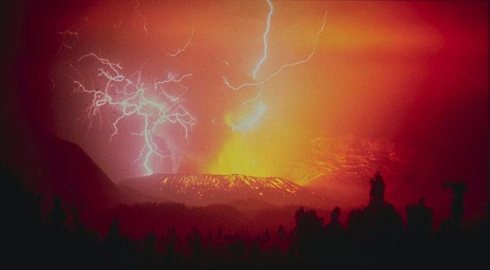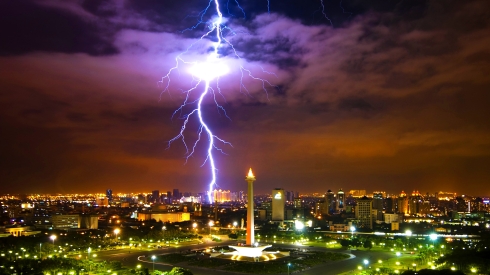Hey Dad – Let’s Talk is a series of activities that allows Dad’s to spend time and bond with their kids. They include a variety of Creative activities from Riddles, Puzzles, Information Tit Bits, Trivia, Quiz, stories etc. Activities that you can discuss, stuff that is interesting and exploratory. Each activity should take 20 – 30 minutes and the best time to spend time with your kids is before you tuck them to Bed.
_________________________________________________________________________
This session is all about Lightning – an amazing spectacle of nature that creates both awe and fear.
What is Lightning ?
Lightning is a powerful burst of electricity that happens very quickly during a thunderstorm. Lightning is caused by an electrical charge in the atmosphere that is unbalanced. The movement of rain and ice inside a thundercloud creates an electrical charge, with the negative charge (electrons) forming at the bottom of the cloud and the positive charge (protons) forming at the top.Opposites attract so the negative charge at the bottom of the cloud seeks out a positive charge to connect with. Lightning can occur inside clouds, between clouds and from clouds to the ground. When lightning strikes the ground it seeks out the shortest route to something with a positive charge, this might be a tree, a tall building or if they’re very unlucky, a person.
What is Thunder ?
Thousands of years ago philosophers such as Aristotle believed that thunder was caused by the collision of clouds. But its actually caused due to a different reason. The intense heat from lightning causes the surrounding air to rapidly expand and create a sonic wave that you hear as thunder. The hot air moves up and the cold air gushes in – causing a huge sound that is Thunder.
Interesting facts about Lightning
- The Earth has nearly 100 lightning strikes per second – thats 3.6 billion per year ! Lightning strikes usually last around 1 or 2 microseconds. The Earth has about 2,000 active thunderstorms at any point of time. Without thunderstorms, the earth would lose its electric charge in less than 1 hour.
- Rwanda, Africa is the lightning capital of the world, receiving nearly 2.5 times the amount of lightning as Florida
- Florida is the Lightning Capital of the U.S. Central Florida, from Tampa to Titusville is “Lightning Alley” in the U.S.. Lightning is the #1 weather killer in Florida – more than all other weather deaths combined.
- Most lightning strikes occur either at the beginning or end of a storm.
- The average temperature of lightning is around 20000 °C (36000 °F) – that is a more than twice as hot as the Sun
- Lightning is only 1 inch in diameter and has been observed over 100 miles long.
- An average lightning flash has the energy of a 1-kiloton explosion. Lightning voltage can be up to 300 million volts.
- Since the late 1980s, there have been several attempts to investigate the possibility of harvesting lightning energy. None have been effective. A solution here can solve the world of its energy crisis.
- Lightning current averages 30,000 amps, but ranges from 10,000 to 200,000 amps – 100 To 1,000 times as strong as a steel welder.
- Corded telephones are not safe and should not be used during thunderstorms. The usual way that current enters a telephone is through the wire. Cloud-to-ground flashes tend to hit tall objects such as utility poles. When a pole is struck, its current enters a building through the wiring, then to the phone, and then straight to your head. Cell phones and cordless phones are safer, but be sure to stand away from the cordless phone’s base as a strong current can possibly arc a few feet from the base to the handset.
- Lightning damage to home electronics usually occurs when lightning strikes to nearby utility poles or wires, then enters the building through power, phone, and TV wires. For direct or indirect hits, the only sure way is to pull the power, phone, and cable plugs on sensitive electronics before thunderstorms threaten. Never touch wires during a thunderstorm, even to unplug your equipment. People have been electrocuted while unplugging their electronics during thunderstorms. Better your computer than you!
- Greek and Roman temples often were erected at sites where lightning struck – They worshipped the gods here in an attempt to appease them.
- If you are in the mountains and lightning begins to strike, you should quickly get below the treeline and get into a grove of small trees. Make absoulutely sure that you are not standing next to a tall tree when you are in the mountains. If you are standing next to a tall tree, you are more likely to get struck by lightning that you are if you are in a group of small trees.
- Lightning rods (also called conductors) are metal rods or similar objects that divert lightning safely to the ground, they can often be seen at the top of tall buildings.
- Most lightning occurs over land rather than oceans, with around 70% of it occurring in the Tropics.
- Thunder is the sound caused by lightning. Because sound travels slower than light you hear the sound of Thunder later. After you see a flash of lightning, count the number of seconds until you hear the thunder. (Use the stop watch or count “One-Mississippi, Two-Mississippi, Three-Mississippi,” etc.) For every 5 seconds the storm is one mile away.
- Lightning is usually produced by Cumulo Nimbus clouds that are very tall and dense.
- Lightning puts 10 million tons of nitrogen into the Earth each year.
- Lightning can also occur during volcanic eruptions, dust storms, snow storms, forest fires and tornadoes. Check out this amazing video of volcano lightning Video Link : http://www.sciencekids.co.nz/videos/earth/volcanolightning.html. ( This may not be a clickable link You may have to paste URL separately in your browser)

- The study of lightning is known as Fulminology and Astraphobia is the fear of thunder and lightning.
- In Indo-European cultures, the Thunder God is frequently known as the chief or king of the gods, e.g. Indra in Hinduism, Zeus in Greek mythology, and Perun in ancient Slavic religion; or a close relation thereof, e.g. Thor, son of Odin, in Norse mythology

- As Fast as Lightning is a commonly used speech – but the truth is Lightning travels slower than the speed of Light.The bottom tip of a lightning bolt traveling from a cloud to the ground does travel rather quickly, although it travels at much less than the speed of light. A lightning discharge consists of electrons which have been stripped from their molecules flying through the air. They are accelerated by a strong electric field, a consequence of the big voltage difference between the cloud and the ground. They crash into air molecules on their way down and free other electrons, making a tube of ionized air.
The “leader”, the first stroke of a lightning discharge, actually proceeds in steps – lengthening by about 30 meters at a time, taking about a microsecond (one millionth of a second) to do each step. There is a pause between steps of about 50 microseconds. The whole process may take a few milliseconds (one-thousanths of a second), providing enough time to perceive motion. Most of the charge flows after this leader makes electrical contact with the ground, however. A powerful “return stroke” releases much more energy. That’s not the whole story, however – a lightning flash may have only one return stroke or may have several tens of strokes using the same column of ionized air. It may seem to flicker.

Leave a Reply